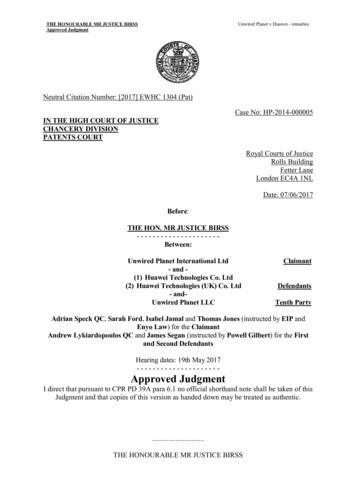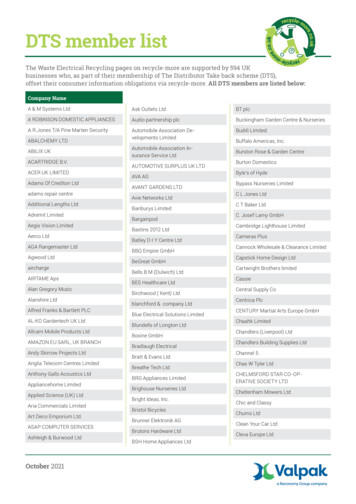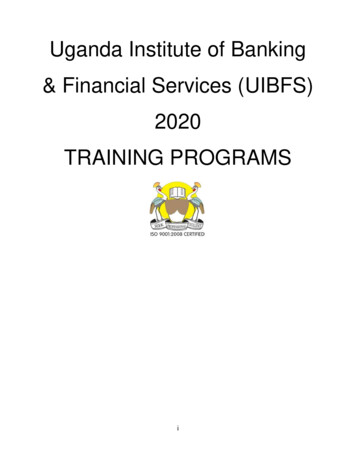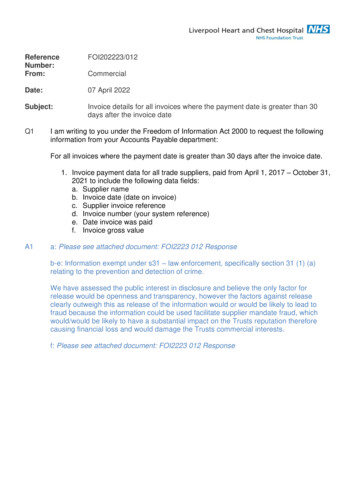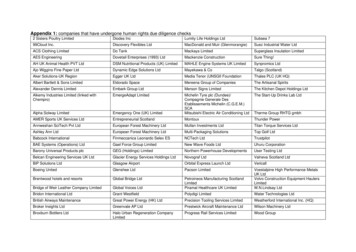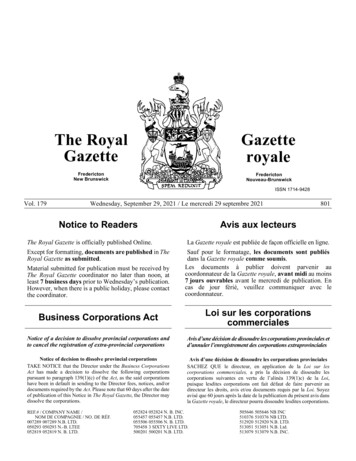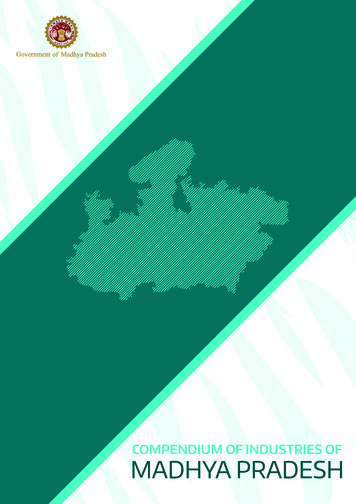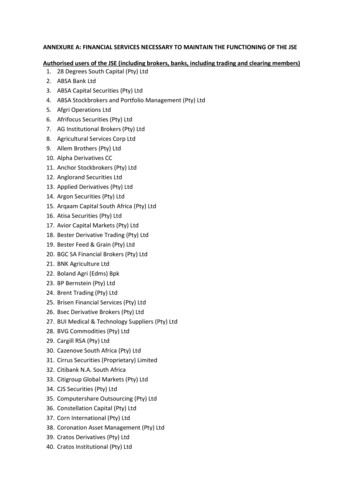
Transcription
[2020] UKSC 37On appeals from: [2018] EWCA Civ 2344and [2019] EWCA Civ 38JUDGMENTUnwired Planet International Ltd and another(Respondents) v Huawei Technologies (UK) Co Ltdand another (Appellants)Huawei Technologies Co Ltd and another(Appellants) v Conversant Wireless LicensingSÀRL (Respondent)ZTE Corporation and another (Appellants) vConversant Wireless Licensing SÀRL (Respondent)beforeLord ReedLord HodgeLady BlackLord BriggsLord SalesJUDGMENT GIVEN ON26 August 2020Heard on 21, 22, 23 and 24 October 2019
Appellants (Huawei)Mark Howard QCDaniel Alexander QCAndrew Lykiardopoulos QCHenry Forbes SmithJames Segan(Instructed by Allen & OveryLLP (London) & PowellGilbert LLP)Appellants (ZTE)Michael Bloch QC(Instructed by Bristows LLP)Respondents (Unwired)Adrian Speck QCSarah Ford QCIsabel JamalThomas Jones(Instructed by EIP Legal &Osborne Clarke)Respondent (Conversant)Adrian Speck QCSarah Ford QCColin WestIsabel JamalThomas Jones(Instructed by EIP Legal)1st Intervener (Apple Inc)(written submissions only)Hugh Mercer QC(Instructed by Wilmer CutlerPickering Hale and Dorr LLP)2nd Intervener (Ericsson)(written submissions only)James Marshall (Solicitor)Xuyang Zhu (Solicitor)(Instructed by Taylor WessingLLP (London))3rd Intervener(Qualcomm Inc)(written submissions only)Nicholas Saunders QC(Instructed by Quinn EmanuelUrquhart & Sullivan UK LLP(London))Appellants:(1)Huawei Technologies Co Ltd and another(2)ZTE Corporation and anotherRespondents:(1)Unwired Planet International Ltd and another(2)Conversant Wireless Licensing SARL
JUDGMENT OF THE COURT:1.These appeals raise several matters which are important to the internationalmarket in telecommunications. The first (in all three appeals) is whether a court inthe United Kingdom (“UK”) has jurisdiction and may properly exercise a power,without the agreement of both parties, to (a) grant an injunction to restrain theinfringement of a UK patent where the patented invention is an essential componentin an international standard of telecommunications equipment, which is marketed,sold and used worldwide, unless the implementer of the patented invention entersinto a global licence of a multinational patent portfolio, and (b) determine royaltyrates and other disputed terms of such a global licence. Secondly, there is a dispute(in the Conversant appeals: para 17 below) whether England is the appropriateforum to determine those matters. Thirdly, (in the Unwired appeal: para 16 below)there is a question as to the nature of the requirement that the licence, which theowner of a Standard Essential Patent (“SEP”) must offer to an implementer, be nondiscriminatory. Fourthly, (again in the Unwired appeal) there is a question whetherthe court should refuse to grant the owner of such a SEP an injunction on the groundthat it has breached EU competition law because it has not complied with theguidance given in the judgment of the Court of Justice of the European Union(“CJEU”) in Huawei v ZTE (Case C-170/13) EU:C:2015:477; [2015] 5 CMLR 14;[2016] RPC 4. Fifthly, the appeals raise a more general question as to thecircumstances in which it is appropriate for an English court to grant a prohibitoryinjunction or to award damages instead. Each member of the panel has contributedto this judgment which addresses those matters.Patents: the legal background2.The starting point is the “patent bargain” which promotes innovation andjustifies the monopoly which a patent gives an inventor. The patent bargain is this:an inventor receives the reward of a time-limited monopoly of the industrial use ofits invention in return for disclosing the invention and dedicating it to the public foruse after the monopoly has expired. See for example Actavis Group PTC EHF vICOS Corpn [2019] UKSC 15; [2019] Bus LR 1318, para 53. The patents conferringsuch monopoly rights are national in scope and are usually conferred by nationalgovernments. Legal questions as to their validity and their infringement aredetermined by the national courts of the state which has conferred the patent rightor, in the case of a European patent, in a designated state. An inventor has to protectits invention by applying for patents to the national authorities of each of those statesin which it seeks to obtain a monopoly (unless it obtains a patent from the EuropeanPatent Office under the European Patent Convention which creates a nationallyenforceable patent within each designated state). It is not unusual for a nationalPage 2
patent for an invention to be upheld by the courts of one state and another nationalpatent for what in substance is the same invention to be invalidated by the courts ofanother state. Within Europe, the same European patent can on occasion be upheldby the courts in one signatory state but be invalidated in another. Much may dependon the differing evidence led and arguments advanced in national legal proceedings.3.In English law, once a patent owner has established that a patent is valid andhas been infringed, it is prima facie entitled to prevent further infringement of itsproperty rights by injunction. In Scots law an interdict provides a similar remedy.We discuss this matter (the fifth issue) in more detail in paras 159-169 below. Thisprima facie entitlement and the patent owner’s entitlement in other jurisdictions toobtain similar prohibitory remedies form part of the backdrop to the contractualarrangements which lie at the centre of these appeals.4.To promote the development of global markets for telecommunicationsproducts, including mobile phones, the infrastructure equipment and devicesproduced by competing manufacturers need to communicate and inter-operate withone another and the phones need to be available for use internationally by consumerswho travel with their phones from one jurisdiction to another. Two attributes ofpatent law have militated against this development. First, the prima facie entitlementof the owner of a patent to prohibit by injunction the use of its invention within anational jurisdiction has the potential to disrupt a global market for equipment usingthat invention. Secondly, the national nature of patent monopolies, which forces thepatent owner seeking to protect its monopoly to raise proceedings in individualnational courts, makes it very difficult, if not wholly impracticable, for a patentowner to protect an invention which is used in equipment manufactured in anothercountry, sold in many countries and used by consumers globally. The first attributemay give owners of patents included in an agreed standard excessive power todisrupt an otherwise global market to the prejudice of manufacturers of equipmentusing such inventions (“implementers”) and to exact excessive royalties for the useof their inventions. The second attribute may enable implementers to avoid payingan inventor a proper price for the use of its invention internationally. There wastherefore potential for the alternative evils of the abuse by a patent owner of itsmonopoly rights and of the denial by implementers of the patent owner’s legitimaterights. Organisations involved in the telecommunications industry have sought toaddress those evils by establishing Standard Setting Organisations (“SSOs”) towhich they bring their most advanced technologies, promoting standards using thosetechnologies, and putting in place contractual arrangements to which we now turn.SSOs aim to promote both technological innovation, which is made available to thepublic, and competition between manufacturers, and thereby to benefit consumersthrough more convenient products and services, interoperability, lower productcosts and increased price competition.Page 3
Standard Setting Organisations5.Telecommunications SSOs have been established in China, Europe, India,Japan (two), South Korea and the United States. The first telecommunications SSOwas the European Telecommunications Standards Institute (“ETSI”), which is aFrench association formed in 1988 and which has adopted an intellectual propertyrights (“IPR”) policy and contractual framework governed by French law. ETSI isrecognised as the SSO in the European Union telecommunications sector. It has over800 members from 66 countries across five continents. Its purposes, as set out inarticle 2 of its Statutes (5 April 2017), include the production of “the technicalstandards which are necessary to achieve a large unified European market fortelecommunications [etc]” and “to contribute to world-wide standardization” in thatfield. SSOs bring together industry participants to evaluate technologies forinclusion in a new standard. ETSI is the relevant SSO as the patents which are thesubject of these appeals are the UK designations of European patents (“UK patents”)which have been declared to ETSI as essential. The relevant standards in theseappeals are telecommunications standards for 2G (GSM), 3G (UMTS) and 4G(LTE) telecommunications equipment and devices. The seven SSOs havecooperated to form the 3rd Generation Platform Partnership (3GPP) to develop andoversee those standards. ETSI through its secretariat manages the process by whichits members contribute to the development of international standards. Participantsin SSOs have an incentive to put forward their technology as a component of aproposed standard as inclusion in the standard ensures a market for the technology.Alternative technologies which are not included in a standard may well disappearfrom the market. Participants also accept obligations to declare IPRs which mightpotentially have an effect on the implementation of standards developed by theSSOs.6.Although it is necessary to examine the arrangements in more detail below,it may be useful to give an overview of how ETSI deals with “Essential IPRs”, aterm which we equate with SEPs, when it devises those standards. Owners ofpatented inventions which might be used in a telecommunications industry standard,which is under preparation, declare their patents to ETSI. When considering whetherto include a technology in a standard, ETSI requires the patent owner to enter intoan irrevocable undertaking or contract with it to allow implementers of the standardto obtain a licence to use the relevant patented technology on fair, reasonable andnon-discriminatory (“FRAND”) terms. If the declared patented invention is includedin a standard and it is not possible to make, sell, use or operate etc equipment ormethods which comply with the standard without infringing that IPR, it is treated asan “Essential IPR”. The irrevocable undertaking to give a licence on FRAND termsto implementers applies to any such Essential IPRs. But ETSI is not under anobligation to check whether patents declared to be essential are in fact essential. Nordoes ETSI make any binding judgment on the validity or status of any such patents:ETSI Guide on IPRs (19 September 2013) (“the Guidance”) para 3.2.1. Those arePage 4
matters for the relevant national courts. ETSI leaves it to the relevant parties, if theyso wish, to resolve those questions by court proceedings or alternative disputeresolution: the Guidance para 4.3.7.The purpose of the ETSI IPR Policy is, first, to reduce the risk that technologyused in a standard is not available to implementers through a patent owner’sassertion of its exclusive proprietary interest in the SEPs. It achieves this byrequiring the SEP owner to give the undertaking to license the technology onFRAND terms. Secondly, its purpose is to enable SEP owners to be fairly rewardedfor the use of their SEPs in the implementation of the standards. Achieving a fairbalance between the interests of implementers and owners of SEPs is a central aimof the ETSI contractual arrangements.The ETSI IPR Policy8.The ETSI IPR Policy (“the IPR Policy”) is a contractual document, governedby French law. It binds the members of ETSI and their affiliates. It speaks (clause15(6)) of patents which are inevitably infringed by the sale, lease, use, operation etcof components which comply with a standard as “Essential IPR”. By requiring anIPR holder whose invention appears to be an Essential IPR to give an irrevocableundertaking to grant a licence of the IPR on FRAND terms, it creates a “stipulationpour autrui”, in other words an obligation which a third-party implementer canenforce against the IPR holder. The IPR Policy falls to be construed, like othercontracts in French law, by reference to the language used in the relevant contractualclauses of the contract and also by having regard to the context. In this case, thatcontext is both the external context and the internal context of the IPR Policydocument itself, such as the policy objectives declared in the document.9.The external context includes (i) the Guidance (above) which ETSI hasproduced on the operation of the IPR Policy, (ii) ETSI’s statutes (above), (iii) theglobalised market which ETSI and other SSOs were and are seeking to promote,which we have discussed in para 4 above, and (iv) the fact that ETSI is a bodycomprising experts and practitioners in the telecommunications industry who wouldbe expected to have a good knowledge of the territorial nature of national patents,the remedies available to patent owners against infringement of their patents, theneed to modify by contract the application of patent law to promote the developmentof a globalised market in telecommunications products, and the practice of theindustry in negotiating patent licensing agreements voluntarily.10.The policy statements which provide the internal context include theobjectives set out in clause 3 of the IPR Policy. They include the statement in clause3.1 that the IPR Policy:Page 5
“seeks to reduce the risk to ETSI, MEMBERS, and others applyingETSI STANDARDS and TECHNICAL SPECIFICATIONS, thatinvestment in the preparation, adoption and application ofSTANDARDS could be wasted as a result of an ESSENTIAL IPR fora STANDARD or TECHNICAL SPECIFICATION beingunavailable.”That statement clearly reveals a policy of preventing the owner of an Essential IPRfrom “holding up” the implementation of the standard. But that policy is to bebalanced by the next sentence of clause 3.1 which speaks of seeking a balance, whenachieving that objective, “between the needs of standardization for public use in thefield of telecommunications and the rights of the owners of IPRs.” The importanceof protecting the rights of the owners of IPRs is declared in the second policyobjective (clause 3.2) in these terms:“IPR holders whether members of ETSI and their AFFILIATES orthird parties, should be adequately and fairly rewarded for the use oftheir IPRs in the implementation of STANDARDS and TECHNICALSPECIFICATIONS.”This objective seeks to address the mischief of “holding out” by whichimplementers, in the period during which the IPR Policy requires SEP owners notto enforce their patent rights by seeking injunctive relief, in the expectation thatlicence terms will be negotiated and agreed, might knowingly infringe the owner’sEssential IPRs by using the inventions in products which meet the standard whilefailing to agree a licence for their use on FRAND terms, including fair, reasonableand non-discriminatory royalties for their use. In circumstances where it may wellbe difficult for the SEP owner to enforce its rights after the event, implementersmight use their economic strength to avoid paying anything to the owner. They mayunduly drag out the process of licence negotiation and thereby put the owner toadditional cost and effectively force the owner to accept a lower royalty rate than isfair.11.Having looked at context, we turn to the operative clauses of the IPR Policy.A member of ETSI is obliged to use its reasonable endeavours to inform ETSI in atimely manner of Essential IPRs during the development of a standard or technicalspecification. If a member submits a technical proposal for a standard or technicalspecification it is obliged to inform ETSI of its IPRs which might be essential (clause4.1). Clause 4.3 confirms that this obligation of disclosure applies to all existing andfuture members of a “patent family” and deems the obligation in respect of them tobe fulfilled if an ETSI member has provided details of just one member of the patentfamily in a timely manner, while also allowing it voluntarily to provide informationto ETSI about other members of that family. A “patent family” is defined as “all thePage 6
documents having at least one priority in common, including the prioritydocument(s) themselves” and “documents” in this context means “patents, utilitymodels, and applications therefor” (clause 15(13)). The patent family thus extendsto patents relating to the same invention applied for and obtained in severaljurisdictions. It shows an intention for the arrangement to apply internationally. Thisis important because the undertaking to grant a licence under clause 6, to which wenow turn, extends to all present and future Essential IPRs in that patent family.12.The key to the IPR Policy is clause 6, which provides the legal basis on whichan owner of an Essential IPR gives an irrevocable undertaking to grant a licence andthereby protects both ETSI and implementers against “holding up”. Clause 6.1provides so far as relevant:“When an ESSENTIAL IPR relating to a particular STANDARD orTECHNICAL SPECIFICATION is brought to the attention of ETSI,the Director-General of ETSI shall immediately request the owner togive within three months an irrevocable undertaking in writing that itis prepared to grant irrevocable licences on fair, reasonable and nondiscriminatory (‘FRAND’) terms and conditions under such IPR ”It provides that the licences must at least cover the manufacture of equipment, thesale, lease or other disposal of equipment so manufactured, and the repair, use oroperation of such equipment. FRAND licensing undertakings made pursuant toclause 6 are intended to bind all successors-in-interest in respect of a SEP, and upontransfer of a SEP the SEP owner is required to take steps to ensure that this isachieved (clause 6.1bis). The undertaking made in respect of a specified member ofa patent family is applied to all existing and future Essential IPRs of that patentfamily unless specified IPRs are excluded in writing when the undertaking is made(clause 6.2). It is envisaged in the IPR Policy that this process will usually take placewhile ETSI is working to create a standard because clause 6.3 provides that, if theIPR owner does not grant the requested undertaking, relevant office-bearers in ETSIwill decide whether to suspend work on the relevant parts of the standard ortechnical specification until the matter is resolved, or to submit any relevant standardor technical specification for adoption. Similarly, if, before a standard or technicalspecification is published, an IPR owner is not prepared to license an IPR, clause8.1 provides for the adoption of a viable alternative technology for the standard ortechnical specification if such a technology exists. If such technology does not exist,clause 8.1 provides an option for work on the standard or technical specification tocease. If the refusal to grant a licence occurs after ETSI has published a standard ora technical specification, clause 8.2 provides the option of modifying the standardso that the relevant IPR is no longer essential.Page 7
13.Clause 6bis instructs members of ETSI to use one of the declaration formsannexed to the Policy. So far as relevant, the licensing declaration is an irrevocabledeclaration by the declarant and its affiliated legal entities that, to the extent thatdisclosed IPRs are or become and remain Essential IPRs, they (a) are prepared togrant irrevocable licences in accordance with clause 6.1, and (b) will comply withclause 6.1bis.14.It appears from this brief review of the IPR Policy in its context that thefollowing conclusions may be reached. First, the contractual modifications to thegeneral law of patents are designed to achieve a fair balance between the interestsof SEP owners and implementers, by giving implementers access to the technologyprotected by SEPs and by giving the SEP owners fair rewards through the licencefor the use of their monopoly rights. Secondly, the SEP owner’s undertaking, whichthe implementer can enforce, to grant a licence to an implementer on FRAND termsis a contractual derogation from a SEP owner’s right under the general law to obtainan injunction to prevent infringement of its patent. Thirdly, the obtaining ofundertakings from SEP owners will often occur at a time when the relevant standardis being devised and before anyone may know (a) whether the patent in question isin fact essential, or may become essential as the standard is developed, in the sensethat it would be impossible to implement the standard without making use of thepatent and (b) whether the patent itself is valid. Fourthly, the only way in which animplementer can avoid infringing a SEP when implementing a standard and therebyexposing itself to the legal remedies available to the SEP owner under the generallaw of the jurisdiction governing the relevant patent rights is to request a licencefrom the SEP owner, by enforcing that contractual obligation on the SEP owner.Fifthly, subject only to an express reservation entered pursuant to clause 6.2, theundertaking, which the SEP owner gives on its own behalf and for its affiliates,extends to patents in the same patent family as the declared SEP, giving theimplementer the right to obtain a licence for the technology covering severaljurisdictions. Finally, the IPR Policy envisages that the SEP owner and theimplementer will negotiate a licence on FRAND terms. It gives those parties theresponsibility to resolve any disputes as to the validity of particular patents byagreement or by recourse to national courts for determination.Industry practice in negotiating licensing agreements15.The parties do not dispute that SEP owners, which have a large portfolio ofpatents covering many countries, and implementers, which market their products inmany countries, would as a matter of practice voluntarily negotiate worldwidelicences, or at least licences from which a given territory is carved out while the restof the world is licensed. Implementers in the telecommunications industry are oftenalso owners of many SEPs and negotiate cross-licences with other implementers. AsBirss J explained in his judgment at first instance ([2017] EWHC 2988 (Pat); [2017]RPC 19, para 544), no rational business would seek to license products country byPage 8
country if it could be avoided. This is, as Birss J said, in part because of the effortrequired to negotiate and agree so many different licences and thereafter to keeptrack of so many different royalty calculations and payments. It is also, as herecognised, because businesses and consumers will move mobile handsets acrossborders and an implementer would want to be able to bind the SEP owner intoallowing the entry of otherwise unlicensed handsets into the jurisdictions in whichthe SEP owner had a valid SEP or valid SEPs. The Court of Appeal in its judgmentin the Unwired appeal ([2018] EWCA Civ 2344; [2018] RPC 20, paras 55-56) alsoreferred to the prohibitive cost of litigating the validity and essentiality of patentsterritory by territory. These obvious considerations must have been part of thefactual background of which the expert framers of the IPR Policy were aware whenthey devised that Policy.The parties to the appeals16.In this judgment the court addresses three appeals. In the first, the appellantsare Huawei Technologies Co Ltd (“Huawei (China)”), a Chinese company whichdevelops telecommunications technology and also implements the technology ofothers, and Huawei Technologies (UK) Co Ltd (“Huawei (UK)”), a UK subsidiaryof Huawei (China) (collectively “Huawei”). The respondents are Unwired PlanetInternational Ltd and Unwired Planet LLC (collectively “Unwired”) which areregistered in Ireland and the United States of America respectively. They are bothintellectual property licensing companies (sometimes called “Patent AssertionEntities”) which obtain income from the licensing of patents to companies whichmake and sell telecommunications equipment. In 2013 Unwired acquired a portfolioof patents and patent applications from Ericsson, which was a major developer oftelecommunications technology and a participant in standard setting. At the time oftrial, the portfolio covered 42 countries and comprised 276 patents and applicationsdeclared as essential, of which 29 were UK patents or applications. Each of Ericssonand Unwired made an ETSI IPR Licensing Declaration and a Specific IPR LicensingDeclaration in respect of patent families which encompass five of the UK patents onwhich Unwired sued Huawei in England. Ericsson had licensed patents to Huawei,including the UK patents which are the subject of these proceedings, but the licenceexpired in 2012. Huawei’s continued use of the technology covered by the patentsin suit forms the backdrop to its appeal.17.In the second and third appeals the appellants are respectively (i) Huawei and(ii) ZTE Corporation (“ZTE (China)”), a Chinese company, and its UK subsidiaryZTE (UK) Ltd (“ZTE (UK)”), collectively “ZTE” and both part of the ZTE group,which is a global supplier of telecommunications and information technologyequipment. The respondent in both appeals is Conversant Wireless Licensing SÀRL(“Conversant”), a company registered in Luxembourg and part of a Canadian groupof companies which is managed from the United States. It is an intellectual propertylicensing company or Patent Assertion Entity, which licenses patents for royaltyPage 9
income. Conversant acquired a portfolio of about 2,000 patents and patentapplications, covering over 40 countries, from Nokia in 2011. Conversant pleadsthat the portfolio includes 28 patent families which are essential. It also pleads thatit and/or Nokia have given an ETSI IPR Licensing Declaration and a Specific IPRLicensing Declaration in respect of its portfolio, which include the UK patents insuit, and that Conversant gave a General IPR Licensing Declaration on 22 July 2014.18.We also received short written interventions from Apple Inc, Ericsson andQualcomm Incorporated, in which three important players in thetelecommunications industry set out their views on industry practice and on theprincipal issues of these appeals, including the interpretation of the IPR Policy. Weare very grateful for their assistance.The legal proceedings(i)Unwired v Huawei19.Unwired commenced proceedings in England on 10 March 2014 againstHuawei, Samsung and Google, alleging infringement of the UK designation of sixEuropean patents (“EP”), and requesting, among other remedies, an injunction toprevent further infringement. Unwired began parallel proceedings in Germany at thesame time. Before the proceedings commenced, Unwired and Huawei had discussedthe possibility of Huawei buying some of Unwired’s patents but Huawei did not doso. We discuss the further exchanges between Unwired and Huawei, both before theproceedings commenced and during the course of those proceedings, when weaddress the fourth issue (whether the court should refuse an injunction because ofany failure to comply with the guidance of the CJEU in Huawei v ZTE) in paras 128158 below.20.In 2015 and 2016 three trials were held to determine whether the UK patentsin suit were valid and infringed. After a seven-day trial, Birss J held that one patent(EP ‘744) was both valid and essential. His findings were upheld on appeal. In thesecond trial, after a hearing over eight days, two patents (EP ‘287 and EP ‘514) wereheld to be invalid, permission to appeal was granted, and the appeal was stayed inJuly 2017. In the third trial, after a five-day hearing, a patent (EP ‘818) was held tobe valid and essential. Permission to appeal was granted and the appeal was stayedin July 2017. The equivalent technical trial on the remaining UK SEP (EP ‘991) hasbeen postponed indefinitely.21.At the same time Unwired brought proceedings in Germany, in which it hadmixed success and from which appeals are pending. In particular, the GermanPage 10
designation of EP ‘744 has been held to be valid but not infringed and an appeal oninfringement is pending. The German designations of EP ‘287 and EP ‘514 havebeen held to be infringed but the Opposition Division of the European Patent Officehas held those patents to be invalid and appeals from those decisions to the EPOTechnical Board of Appeal are pending. The German designation of EP ‘818 hasbeen held to be valid and infringed and those judgments have been upheld on appeal.The claims of EP ‘991 which were alleged to be infringed were revoked for theGerman designation and an appeal against that judgment is pending, as is aproceeding relating to the infringement of that patent.22.Huawei (China) challenged several of Unwired’s patents in China. The PatentRe-examination Board (“PRB”) has held that two Chinese family members ofUnwired’s European patents (EP ‘287 and ‘514) are invalid but those findings areunder appeal. The PRB has held the Chinese family member of EP ‘744 to be validand Huawei (China) has appealed. Huawei (China) has also challenged five otherpatents, which Unwired declared to be SEPs; three have been upheld, one upheld inpart and one invalidated. Appeals from those decisions are pending.23.As matters currently stand, and subject to continuing appeal proceedings inGermany and China, Huawei has been held to be infringing one or more ofUnwired’s SEPs through its use of patented technology in both the UK and Germanyand in China challenges to two patents have failed.24.Unwired settled with Google in 2015 and with Samsung in July 2016, afterthe technical trials of the UK patents but before Birss J held the trial to determineremedies for infringement of its UK patents, in an arrangement in which it grantedSamsung a global licence for its po
forum to determine those matters. Thirdly, (in the Unwired appeal: para 16 below) there is a question as to the nature of the requirement that the licence, which the owner of a Standard Essential Patent ("SEP") must offer to an implementer, be non-discriminatory. Fourthly, (again in the Unwired appeal) there is a question whether

